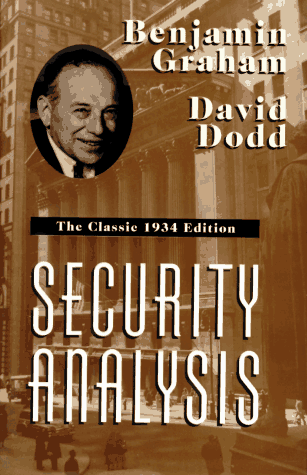Secrets Of Warren Buffett – What Is Value Investing? Part 1
Share this article
Many of you are probably familiar with the term value investing and see Warren Buffett as the poster boy for it. But did you know that value investing started out very differently from Buffett’s famous investments like See’s Candies, Coca-Cola and American Express?
To know how it evolved, we have to start from its intellectual patriarch. Meet Benjamin Graham – the father of value investing. When Graham first penned down his thoughts about investing in Security Analysis, the term ‘value investing’ wasn’t even coined yet. But to Graham, he already had his own distinct ideas on how to differentiate a company’s stock price and its intrinsic value.

Benjamin Graham & David Dodd – The Classic 1934 Edition Security Analysis
Security Analysis
Security Analysis’s first edition was published in 1934 and America had just gone through one of the most severe economic recessions in the 20th Century – the Great Depression of 1929. The stock market collapsed as well and there were many publicly listed companies that were worth more dead than alive.
In other words, those companies were selling for less than their liquidation values. Graham’s analysis was very much on the Balance Sheet – what those companies owned and owed. In fact, he ran his own very successful hedge fund, the Graham-Newman Corporation (which had annual returns of around 20% from 1936 to 1956), using a technique which relied extensively on Balance Sheet analysis.
The technique was called Net-Net and it can actually be expressed in a simple formula:
Net-Net = Current Assets – Total Liabilities
Graham wanted to find stocks that were selling at two-thirds its Net-net value because he wanted a Margin of Safety. He knew that stocks selling at such depressed valuations were often in trouble in some way or another and so, wanted to use a very low buying price as a buffer in case things did not work out.
To increase his odds of success, Graham also diversified widely, with some accounts saying he had more than 100 stocks in his portfolio at any one time. By diversification, he allowed the natural laws of statistics to play out with the stocks in his portfolio. Surely, such cheap stocks will rebound in price as people realised the folly of leaving a company worth more ‘dead than alive’, especially when they had minimal debt loads and were still making profits, he thought.
Graham’s investing style could not be more aptly named than ‘cigar-butt’ investing. Warren Buffett coined the term when he described Graham’s investing methods as finding a used-cigar lying on the ground that was still good for one final puff – it did not cost a cent and could still provide one enjoyable puff.
Perhaps, Graham’s greatest legacy was leaving the world with the concept of a ‘margin of safety’ – making sure your purchase price is low enough to mitigate any potential mistakes in evaluating a business’s intrinsic value – and Mr. Market. Mr. Market’s an allegory for the stock market as he likened the stock market to an individual suffering from bipolar disorder. The stock market can be extremely euphoric at times, resulting in overpriced stocks, and then swing to despair, resulting in severely under-priced stocks.
As Graham’s student in Columbia Business School, those were the greatest lessons Buffett gleaned from his teacher. But, how did he end up investing in businesses with great economic characteristics – businesses that could grow their profits slowly, but surely, over the years?
Stay tuned then, as we bring you on the journey of how Warren Buffett came to be, starting with him joining the Graham-Newman corporation.
Related Articles
Webinar: Identifying Opportunities in this Volatile Market
Presented by Cayden Chang
Founder of Value Investing Academy and Award-Winning International Speaker, Lifelong Learner Award 2008, Personal Brand Award 2017
You will learn:
- How to navigate market volatility in spite of changes in global trade and interest rates policies
- How an all-weather portfolio of stocks, bonds, and ETFs can help you stay calm and thrive no matter the market direction
- How Cash-Flow Options Strategies (CFOS), modelled after Warren Buffett's principles of Value Investing, support prudent long-term value investing
- Actionable & Duplicable Step-By-Step Value Investing Framework on identifying on identifying and evaluating high-quality companies.

Suitable For
Solutions For
Mind Kinesis Investments Pte Ltd. All Rights Reserved.


